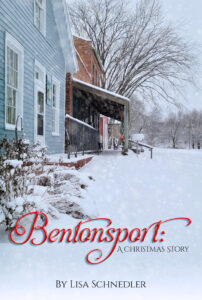By Lisa Schnedler
My novel, Bentonsport: A Christmas Story, is about two people, from two eras, who meet two weeks before Christmas.
 When I sat down to write this novel, I did not plan for it to involve time travel. I intended the story to reflect the emotions I had experienced when I moved from the city I had lived in for 28 years to this small town on the Des Moines River. For the first six months, I felt lonely, isolated, and “different.”
When I sat down to write this novel, I did not plan for it to involve time travel. I intended the story to reflect the emotions I had experienced when I moved from the city I had lived in for 28 years to this small town on the Des Moines River. For the first six months, I felt lonely, isolated, and “different.”
But, over time, I fell in love with my small town of Bentonsport. One day, as I was walking the streets of my tiny village, I wondered what someone who had lived in this river town back when it was growing and bustling would think of the town today. No steamboats. Few remaining houses. No mills along the river. All gone.
And, I thought—I bet they would feel like I did when I first came here. Lost. Lonely. Sad.
But, I realized that what made me fall in love with my small village—a small community of artists—would likely have the same impact on them. They would enjoy the people. Enjoy the close relationships, the beauty of the area, and the peace.
So, I decided that instead of the story involving a city-to-small town move, the story would involve time travel—with all the same emotions.
After reading one of the first drafts of my novel, my editor told me in no uncertain terms that although perhaps I was immersed in the story—and in the town of Bentonsport—the reader, at this point, was not.
She told me that what was missing was the small details sprinkled here and there that bring a story to life: The smell of the room, the taste of the food, and the sounds you hear as you walk outdoors.
Although I was part of the world I was writing about, I hadn’t enticed the reader into it.
At that point, I was never so happy that I was writing about the “most wonderful time of the year.” Just say “Christmas,” and your senses are suddenly flooded:
The smell of the pine rope that encircles doorways.
The fragrance of the orange studded cloves that sit in bowls.
The flicker of the candlelight dancing across tabletops.
The taste of warm cookies, fresh from the oven.
It was all there—so much to share!
So, I “colored” my story’s outlines with the sense-laden Christmas elements.
But that was not enough.
“Go deeper,” my editor said. “Don’t rely just on Christmas. Bring out the richness of the characters.”
And, having learned how to color my story with all that is Christmas, I had to pick up a much more delicate brush and focus on the characters, the rooms, and the landscape.
A tendril of blonde hair caressed her face.
The smell of vanilla permeated her clothes.
The crack of ice on the river.
Finer painting. Subtle shading. Brush stroke by brush stroke, bringing the characters to life in the readers’ minds as they had been in mine from the beginning.
Writing truly is art.
Christmas, I found, is a doorway to the senses. But there is so much more to this season.
And, that is where sound, taste, and sight took a back seat to the feelings of the heart and soul.
Christmas is the foundation of our Faith.
The hope, joy, trust, and belief that Christmas brought into this world and that lives in us today was foundational to this story—as it is to our own. Christmas can be “flashy,” – but more importantly, it is foundational.
And, it was here, in this space, that the characters became real.
 Lisa Schnedler writes cozy romances. She is a certified Christian Life Coach, with a Christian life planning ministry, Branch Living, to help Christians live out their God-given purposes. She is president of a health system in Wisconsin. She is a pastor’s wife, mother of three, and grandmother of six.
Lisa Schnedler writes cozy romances. She is a certified Christian Life Coach, with a Christian life planning ministry, Branch Living, to help Christians live out their God-given purposes. She is president of a health system in Wisconsin. She is a pastor’s wife, mother of three, and grandmother of six.
